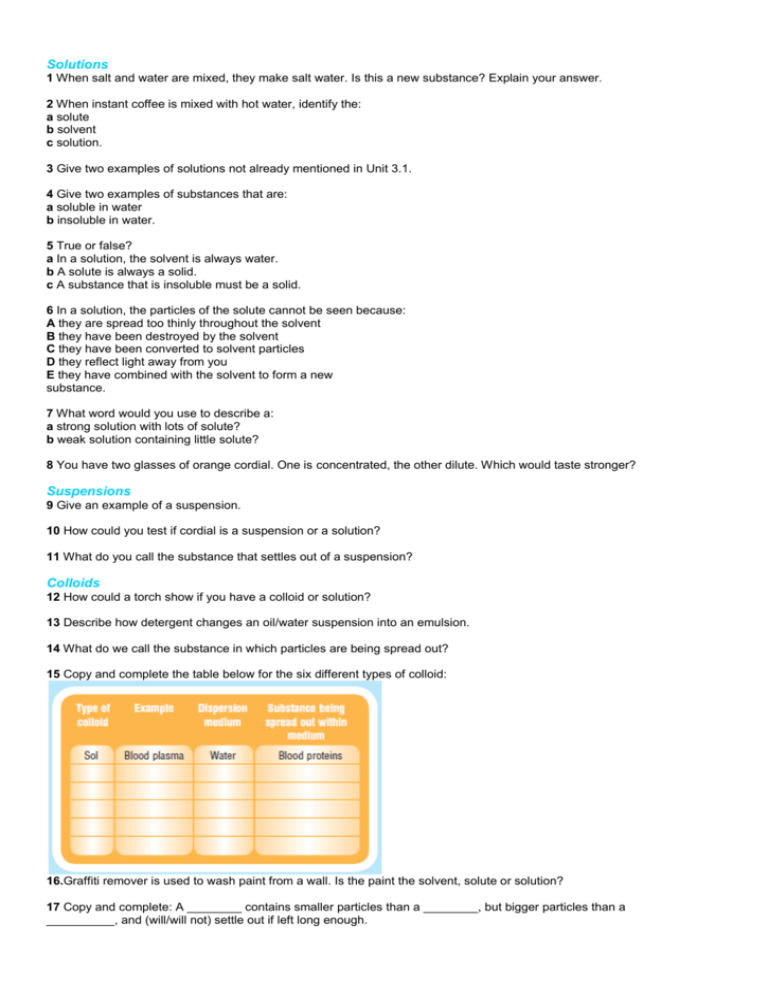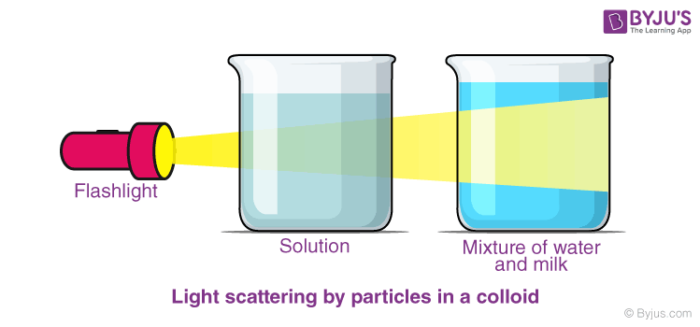how is paint made that it can be classified as a colloid
When dispersed material liquid droplets milk dispersed in solid fat called Butter as. The pigment is added to the resulting liquid of the solvent and binding medium.

Classification Of Colloids Methods Examples Video Lesson Transcript Study Com
Paint is an example of a liquid colloid.

. Thus becoming effectively soluble they. Paint is a colloid due to being dispersed and mixed with acouple different substances. Once water pours into it it becomes more like a solution and acts like one.
Heavy cream latex paint jelly. The egg yolks kept the particles from settling in the water keeping them spread throughout the mixture. This uniform dispersion of pigments is called a colloid.
The plant or mineral gave it color. Hydrocolloids describe certain chemicals mostly polysaccharides and proteins that are colloidally dispersible in water. Fog is made up of liquid water particles suspended in air.
Colloids also known as colloidal solutions or colloidal systems are mixtures in which microscopically dispersed insoluble particles of one substance are suspended in another substance. These pigment particles are responsible for the effects like opacity color and optical illusions. Analogous to the identification of solution components as solute and solvent the components of a colloid are likewise classified according to their relative amounts.
Smoke contains solids suspended in air. 4 Characteristics of colloids Continuous phase and dispersed phase Thermodynamically unstable but kinetically stable ie. In a colloid particles of one substance are mixed and dispersed with particlues of another substance- but they are not dissolved in it.
The colloids they are inhomogeneous mixtures made up of a dispersed phase which is almost always a solid with very small particles and a dispersing or continuous phase which is generally liquid or gaseous. Colloids consist of a dispersed phase and a dispersion medium. Examples of colloids a Gas dispersed in liquid foams Whipped cream consists of tiny air bubbles dispersed in the.
Do colloids and solutions look the same. 2014-08-21 17. The pigment is added to the resulting liquid of the solvent and binding medium.
In the paint the liquid is dispursed into the liquid to form a binding medium ad solvent sollution. Contains holes for moving of paint this machine can use b oth of steel or. They are stable indefinitely Classified in terms of dispersed substance solid liquid gas in dispersing medium solid liquid gas Dispersed phase 101000 nm particles.
Here are some common examples. If the light bounces off the particles you will see the light shine through and you have a colloid mixture. Paint is a colloid due to being dispersed and mixed with a couple different substances.
Is paint a sol colloid. Yes paint identifies as a colloid. Since these have a wide industrial application it is important to have a proper system for the classification of colloids.
Dried paint is typically considered to be a colloid as the dispersed particles are indefinitely spread throughout the binder dispersing medium. Why is butter classified as a colloid. When paints are manufactured the pigments are very finely ground often with the binder to create a particle size that is colloidal.
Paint is a colloid due to being dispersed and mixed with a couple different substances. Colloids are classified according to two main criteria. Paints are a type of mixture called a colloid.
To identify a colloid mixture from a solution you can use the Tyndall effect. They are classified on the basis of different properties of the dispersed phase and the medium. These particles may be either dissolved macromolecules or having macromolecular structures formed from smaller structural units or they may constitute a separate phase as in aerosols powders pigments dispersions emulsions or even finely.
The colloidal particles are distributed in a dispersing medium which can be a solid liquid or a gas. The particulate component typically present in a relatively minor amount is called the dispersed phase and the substance or solution throughout which the particulate is dispersed is called the. Paints are a type of mixture called a colloid.
They fall under the mixture of solution and gel. Let us learn about them here. For a mixture to be classified as a colloid its suspended particles must not.
The water gave the mix liquidity so it could be worked. Homogeneous mixtures with a dispersed phase in this size range may be called colloidal aerosols colloidal emulsions colloidal suspensions colloidal foams colloidal dispersions or hydrosols. Leads for using mills is that theres a still colloid particle not.
The size of the suspended particles in a colloid can range from 1 to 1000 nanometres 10-9 metres. Impeller can be classified to axial radial. Colloids refer to dispersions of small particles usually with linear dimensions from around 1 nm to 10 micrometres.
Paint is a colloid. For example fog and smoke are colloids. When paints are manufactured the pigments are very finely ground often with the binder to create a particle size that is colloidal.
Yes paint identifies as a colloid. This made paint which scientists later defined as a colloid because of how the pigment stays suspended in the mix. Colloids are classified based on.
Butter can be referred as both emulsion colloid and gel colloid. There are no definite boundaries between the substance and the surrounding media. This is where you pass a light through the mixture.
A colloid can also be referred to as a colloid mixture or colloidal mixture or a colloid solution. Dried paint is typically considered to be a colloid as the dispersed particles are indefinitely spread throughout the binder dispersing medium. As a consequence these substances are called paints or dyes.
The affinity of the dispersed phase for the dispersant and the state in which the material is found in the phases that make up the colloid. Colloids A colloid is a mixture whose particles range in size from 1 nm to 1000 nm and do not settle out on standing. Large surface area to volume ratio Size appropriate for scattering light.
Gases and solids canalso be colloids. This is because it can be dispersed in either fat or liquid. The pigment is added to the resultingliquid of the solvent and binding medium.
When the paint stirs slowly tiny pigment particles become suspended and spread evenly all over the liquid. One way to tell the difference between a colloid and a solution isbyhow each looks.

Revision Questions Solutions 1 When Salt And Water Are Mixed They

Chemistry The Central Science Chapter 13 Section 6

Lesson Video Colloids And Suspensions Nagwa

What Is A Colloidal Solution Introduction Colloid Types Video Example
Why Is Paint Described As A Colloid Paint

What Is Colloidal Suspension Examples Of Colloidal Suspensions

Is Paint A Colloid Techiescientist

Solutions Are The Particles Of A Colloid Solid Chemistry Stack Exchange

Is Paint A Colloid Techiescientist

Is Paint A Colloid Techiescientist

Applications Of Colloids Definition Uses Of Colloids With Videos Faqs

Types Of Colloids And Examples Of Colloids Youtube

1 Classification Of Colloidal Systems After 2 Download Table

Lesson Explainer Colloids And Suspensions Nagwa

What Is A Colloidal Solution Introduction Colloid Types Video Example

